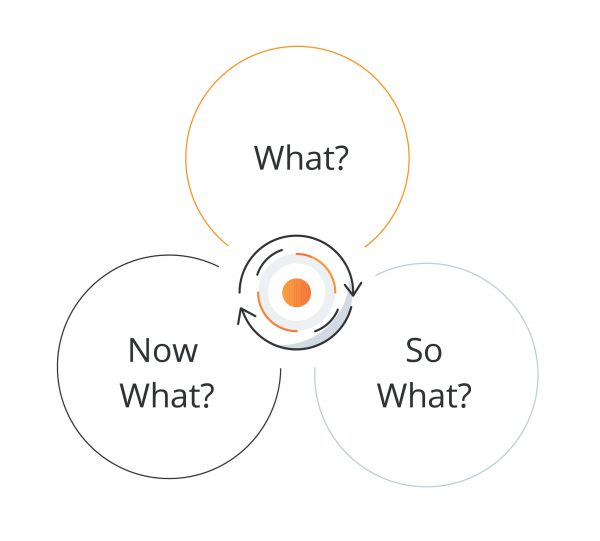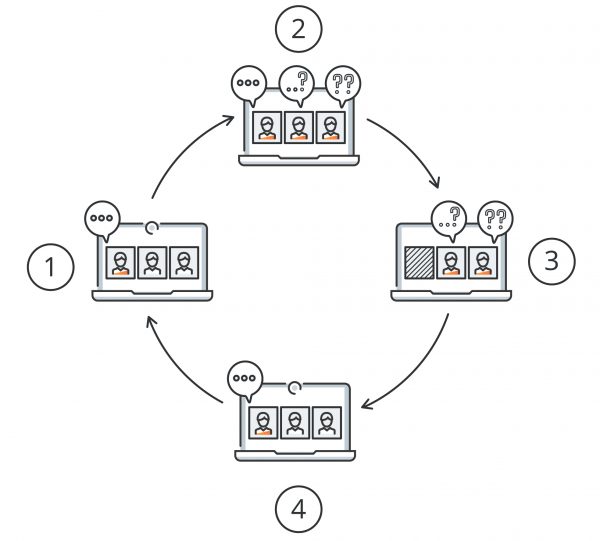
Liberating Structures – how to enliven your meetings?
Activating teams and other groups of people at meetings is not an easy feat. Participants are mostly tired with meetings that bring no value, no conclusion, no action.
Especially now that many of us work from home or decide on hybrid work, there is less chance for casual hallway conversations (which often actually substituted formal meetings).
Liberating Structures may serve as a great tool if you want to activate every single participant in your meeting. Liberating Structures are a collection of over 30 ideas for effective workshops, discussions, and problem-solving meetings, also for large groups.
Below, I will present 3 structures and I hope they will inspire you to experiment with them.
1-2-4-All
This technique can be used if you wish to engage everyone in the group in generating ideas, in a rapid fashion. After stating the question or problem that the participants are going to deal with, the work goes on in the following way:
- Give the participants time to think about a solution individually
- Generate ideas in pairs, based on individual insights
- Share ideas in groups of four to see the similarities and differences
- Every foursome shares one selected idea with the rest of the participants
This way, every person in the group gets a chance to provide a solution; the issue gets analysed from a variety of perspectives; and the participants can be inspiration to each other.
W3 – What, So What, Now What
This method can be used to wrap up past events and make conclusions. The work is done in groups of 5 to 7 people. Make sure that every group includes a person whose task is to facilitate the discussion. Before doing the exercise, the participants should be instructed about what each stage of the discussion must feature.
WHAT
First, there’s time for everyone’s self-reflection, then the groups discuss the facts related to the event analysed. What happened? What did you notice? Together, they write down their observations and share them with the other groups.
SO WHAT
First individually, then in groups, the participants talk about their conclusions based on the situation, hypotheses, patterns, and the significance of what happened. After the discussions within the groups, their results are shared with the others.
NOW WHAT
The discussion is structured in a way similar to the previous stages. The groups think of actions that need to be taken based on their conclusions. After the individual and teamwork, the ideas are presented to the rest of the team. There is also time for additional comments among the groups.
This technique is great for Retrospectives and for larger Lessons Learned meetings.
Troika Consulting
This structure proves useful when you want to consult a problem you’re working on with your colleagues. It will work both at larger meetings, with the participants divided in groups, and in everyday tasks, if you get stuck trying to find a solution. You can get valuable insights from other people and you become more open to asking for help and building trust. The work is done in groups of 3 people. The more versatile the groups, the more creative the solutions are.
The person who initiates the subject of the discussion (“client”) presents the issue to two “consultants”. The consultants ask in-depth questions concerning the analysed issue.
They talk to each other and suggest possible solutions. The client is standing with his or her back to the consultants (or with a disabled camera in the remote environment), not taking active part in the conversation, only listening. Then, the client turns around to face the consultants and to share what was most valuable about their discussion.
Next, another person takes the role of the client and the process is repeated.
All these microstructures are described in detail on the LS website along with numerous examples of how to apply them and the suggested times for each stage. The individual structures can be combined into strings to create plans for longer workshops. If you’re looking for inspiration for non-standard meetings or presentations, this is a great source.
If you’re looking for an experienced IT Partner to build your solution feel free to contact us. We believe each project is unique as each company has different needs. Thus we can adapt our approach and various techniques to a particular case. All to achieve the best quality of a final product.







